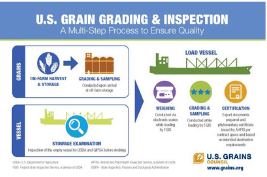
A transparent and reliable understanding of the grain inspection process is essential to global markets and a critical reason the U.S. Grains Council (USGC) works so closely with the U.S. Department of Agriculture’s Federal Grain Inspection Service (USDA’s FGIS) to demonstrate to overseas buyers that the quality of U.S. grains delivered is the quality promised.
For 2020/2021, U.S. grain exports of corn, barley and sorghum are projected to break the all-time grain export record. Marketing year 2019/2020 exports totaled roughly 101.2 million metric tons, equivalent to 4.1 billion bushels, the sixth-best export marketing year of all time.
“One of our main goals is for end-users and importers of feed grains and co-products to understand how the U.S. export system works so they can feel confident about procuring them from the U.S.,” said Ana Ballesteros, USGC marketing director in Latin America. “A well-informed customer will set clear expectations and improve its procurement-related processes when they understand how things are done at origin.”
Congress created FGIS in 1976 to manage the national grain inspection system established in 1916. Today, FGIS facilitates quality standards, handling practices, weighing and inspection services. It ensures U.S. grains products and co-products are graded and accurately labeled for sale in international markets.
Among other things, FGIS provides recommendations for equipment and procedures necessary to effectively sample grain. Through specialized programming, importers can interact with FGIS staff with support from the Council. Recent FGIS workshops have included grain sampling methods in Latin America and Southeast Asia.
“Better processes contribute to overall efficiency, and if our customers are more efficient, we will be contributing to their performance and future growth. We want growing industries that can continue demanding more feed grains and co-products,” Ballesteros said.
Customized programs allow the Council to reinforce its engagement with end-users and importers of corn and corn co-products and, at the same time, provide them with relevant information to strengthen their understanding of the U.S. export system.
“In Southeast Asia, we like to market the ‘total package’ when customers choose U.S. origin. A big component of this added value is the technical servicing we are able to provide through FGIS programs. No other origin is able to provide the support, training and information the U.S. provides through cooperators like USGC and government partners like FGIS,” said Caleb Wurth, USGC assistant regional director of Southeast Asia.
FGIS also works with USGC and consultants to conduct the annual USGC Export Cargo Corn Quality Report. FGIS provides USGC with samples taken directly from its sampling during the grading process on official inspection from export shipments. This allows the USGC Export Cargo Corn Quality Report to be extremely accurate.
“USGC has worked with FGIS – including some individuals personally – for decades to explain how central the grading and inspection process is to U.S. grain exports, which helps us establish trust in the product we are selling and the U.S. as a long-term, reliable supplier. This work is a central part of our long-term market development efforts for both established and new customers,” said Cary Sifferath, USGC senior director of global programs.
Learn more about FGIS workshops and the Council’s participation in them.
About The U.S. Grains Council
The U.S. Grains Council develops export markets for U.S. barley, corn, sorghum and related products including distiller’s dried grains with solubles (DDGS) and ethanol. With full-time presence in 28 locations, the Council operates programs in more than 50 countries and the European Union. The Council believes exports are vital to global economic development and to U.S. agriculture’s profitability. Detailed information about the Council and its programs is online at www.grains.org.
